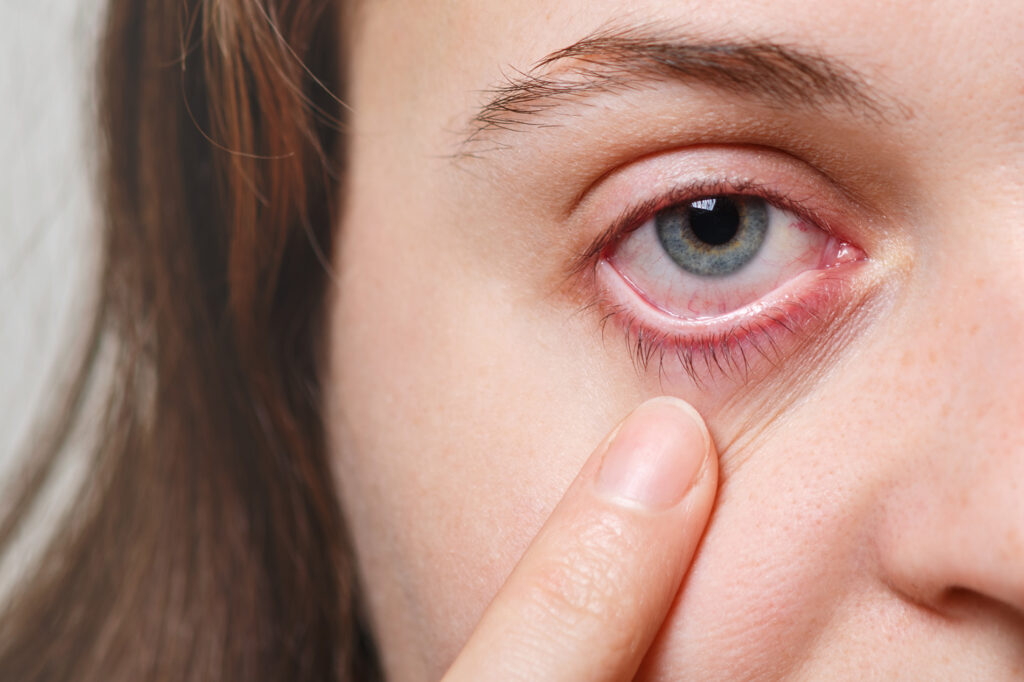A complex syndrome with a high impact on visual functionality.
The ocular surface is normally covered by a hydrolipidic tear film that can protect the corneal and conjunctival epithelium from the external environment.
Evidence supports a two-layer model of the tear film, comprising a thin surface lipid layer overlying a thicker mucous-aqueous mixed layer.
The mucin component of this final layer helps wet the surface of the eye, allowing the component to spread across a surface that is not normally wet.
In case of exposure to external or environmental stressors such as wind, sun, dry air, salt water, smoke, bright light, air conditioning, high temperatures, long-term computer use or contact lens wear, the tear film may change or become so inadequate that it cannot fulfill its protective function. It can also cause symptoms such as irritation, burning, redness and foreign body sensation, which are typical symptoms of dry eye.
Conditions that affect the surface of the eye, such as changes in the tear film, vitamin A deficiency, eye allergies, and the use of preservatives in topical medications.

Kuru Göz mekanizması ve tanımı
“Gözyaşı filminin homeostazisinin kaybıyla karakterize edilen ve oküler semptomların eşlik ettiği, gözyaşı filmi instabilitesi ve hiperosmolaritenin, oküler yüzey inflamasyonunun ve hasarının ve nörosensör anormalliklerinin etiyolojik rol oynadığı oküler yüzeyin kuru multifaktöriyel hastalığı.” (Definition of Tear Film & Ocular Society Dry Eye Workshop II).
LASIK surgery and Dry Eye Syndrome
The change in the tear film can be determined by decreased production of tear fluid or increased evaporation of the same fluid, decreased sensitivity of the ocular surface, especially as it can occur with ocular surface inflammation, contact lenses, corneal surgery – including refractive surgery, leading to decreased aqueous production of the lacrimal glands. Dry eyes are an extremely common result of LASIK (Laser-Assisted in Situ Keratomileusis) surgery (laser-assisted in-situ shaping of the cornea).
Corneal and conjunctival epithelial damage
In general, in critical situations such as ocular surface inflammation, contact lenses, corneal surgery, the cornea and conjunctiva epithelium are more exposed to the entry of pathogens and erosion caused by the constant friction of the eyelid against the eye surface. Epithelial damage is demonstrated histologically by a decrease in the number of goblet mucipar cells and abnormal structures of the corneal and conjunctival epithelium and their constituent cell membranes. This type of damage is detected clinically by colorimetric analysis with specific dyes (Fluorescein, Rose Bengal or lissamine green) and the degree of staining determines the cause of ocular dryness.

Artificial tear treatment
Artificial tears are used as the first therapeutic option for treating any stage of dry eye and contain ophthalmic solutions that can properly moisturize and lubricate the ocular surface. These ophthalmic solutions are often designed using the chemical and physical properties of hydrophilic polymers, which have a moisturizing and lubricating effect by retaining water on the ocular surface.
The ideal composition should be compatible with the physiological properties of the ocular surface epithelium and be able to create a microenvironment in which the epithelium can restore its normal structure and functions in case of damage.
Resorces:
•Changes in the tear film and ocular surface from dry eye syndrome, Johnson ME and Murphy PJ, Progr in Retinal and Eye Res, 2004:23, 449-474.
• Post-LASIK dry eye. Roni M Shtein. Expert Rev Ophthalmol. 2011 October ; 6(5): 575–582
• Tear film and ocular surface tests in animal models of dry eye: uses and limitations, Barabino S, Chen W and Dana MR., Exp Eye Res, 2004: 79, 613-621.
• Artificial tear solutions, Lemp MA, Int Ophthalmol Clin 1973:13, 221-9
• Menoapuse and dry eye. A possible relationship, Versura P, Campos EC, Gynecol ENdocrinol. 2005 May; 20(5): 289-98, Review.
• TFOS DEWS II Report Executive Summary. Jennifer P. Craig, J. Daniel Nelson, Dimitri T. Azar, Carlos Belmonte, Anthony J. Bron, Sunil K. Chauhan, Cintia S. de Paiva, Jos e A.P. Gomes, Katherine M. Hammitt, Lyndon Jones, Jason J. Nichols, Kelly K. Nichols, Gary D. Novack, Fiona J. Stapleton, Mark D.P. Willcox, James S. Wolffsohn, David A. Sullivan. The Ocular Surface (2017)

